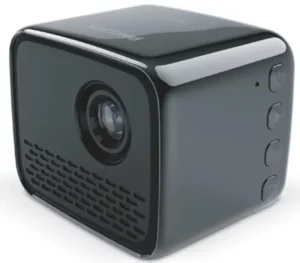

PicoPix Nano
Mini projector
PPX120
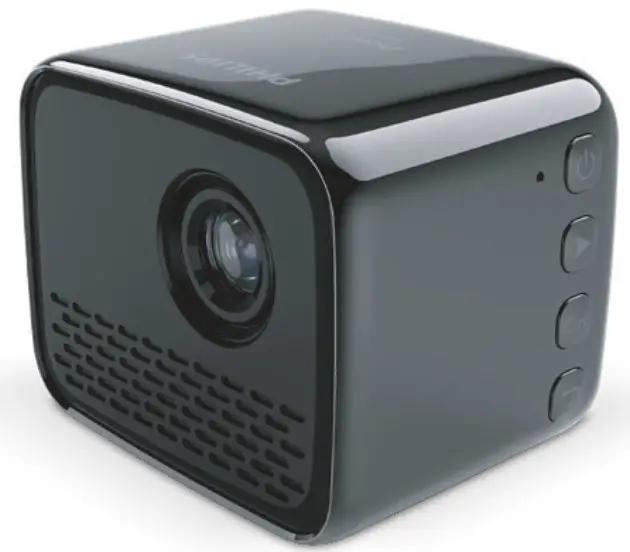
Register your product and get support at
www.philips.com/support
Introduction
Dear customer
Thank you for purchasing this projector. We hope you enjoy this product and the many functions it offers!
About this user manual
The quick start guide supplied with this product allows you to start using this product quickly and easily. Detailed descriptions can be found in the following sections of this user manual. Read the entire user manual carefully. Follow all safety instructions in order to ensure proper operation of this product (see General safety information, page 4). The manufacturer accepts no liability if these instructions are not followed.
Symbols used
Notice
![]() Troubleshooting
Troubleshooting
This symbol indicates tips that will help you in using this product more effectively and easily.
![]()
![]() CAUTION!
CAUTION!
Damage to the product or loss of data!
This symbol gives warning of damage to the product and possible loss of data. Damage can result from improper handling.
What’s in the box
a. Quick Start Guide
b. PicoPix Nano projector (PPX120)
c. 3x power plug adapter (EU, UK, US)
d. USB cable
e. Power adapter
Product highlights
Wireless Screen Mirroring (Android and iOS)
With the Wireless Screen Mirroring function, you can share the screen of your smartphone without a cable. In order to allow screen mirroring, your smartphone must support the screen mirroring feature. This projector works with Miracast-compatible Android phones and iPhones with iOS 7/8/9/10 and 11.
General safety information
Take note of all warnings and safety notes indicated. Do not make any changes or settings that are not described in this user manual.
Incorrect operation and improper handling can lead to physical injury, damage to the product, or loss of data.
Setting up the product
This product is for indoor use only. Place the product securely on a stable, flat surface. To help avoid possible injuries to persons or damage to the product itself, position all cables in such a way that no one will trip over them.
Do not operate the product in damp rooms. Never touch the mains cable or the mains connection with wet hands.
The product must have sufficient ventilation and must not be covered. Do not put the product in closed cabinets, boxes, or other enclosures when in use.
Protect the product from direct sunlight, heat, intense temperature fluctuations, and moisture. Do not place the product in the vicinity of heaters or air conditioners. Observe the information on temperature listed in the technical data (see Technical data, page 16).
Prolonged operation of the product causes the surface to become hot. In case of overheating, the product automatically switches to standby mode.
Do not allow liquids to leak into the product. Turn off the product and disconnect it from the mains supply if liquids or foreign substances leaked into the product. Have the product inspected by an authorized service center.
Always handle the product with care. Avoid touching the lens. Never place heavy or sharp objects on the product or on the power cable.
If the product gets too hot or emits smoke, shut it down immediately and unplug the power cable. Has your product been checked by an authorized service center? Keep the product away from open flames (e.g. candles). The product has a built-in battery. Do not disassemble and modify. The built-in battery should be replaced by qualified service staff only.
Do not try to replace the built-in battery yourself. Incorrect handling of the battery or using the wrong type of battery can cause damage to the product or cause injury.
![]() Risk of explosion with incorrect type of batteries!
Risk of explosion with incorrect type of batteries!
Do not try to replace the built-in battery yourself.
Under the following conditions, a layer of moisture can appear inside the product which can lead to malfunctions:
• if the product is moved from a cold to a warm area;
• after a cold room is heated;
• when the product is placed in a damp room.
Proceed as follows to avoid any moisture buildup:
- Seal the product in a plastic bag before moving it to another room, in order for it to adapt to room conditions.
- Wait for one to two hours before you take the product out of the plastic bag. The product should not be used in a very dusty environment. Dust particles and other foreign objects may damage the product.
Do not expose the product to extreme vibrations. This may damage the internal components. Do not allow children to handle the product without supervision. The packing materials should be kept out of the hands of children. For your own safety, do not use the product during thunderstorms with lightning.
Repairs
Do not repair the product yourself. Improper maintenance can result in injuries or damage to the product. The product must be repaired by an authorized service center. Please find the details of authorized service centers on the warranty card supplied with this product.
Do not remove the type label from this product, as this will void the warranty.
Power supply
Use only a power adapter that is certified for this product (see Technical data, page 16). Check whether the mains voltage of the power supply matches the mains voltage available at the setup location. This product complies with the voltage type specified on the product. The power outlet shall be installed near the product and shall be easily accessible. The capacity of the built-in battery diminishes with time. If the product functions only with AC power supply, the built-in battery is defective. Contact an authorized service center to replace the built-in battery.
![]() CAUTION!
CAUTION!
Always use the button to turn the projector off.
button to turn the projector off.
Turn off the product and unplug from the power outlet before cleaning the surface (see Cleaning, page 13). Use a soft, lint-free cloth. Never use liquid, gaseous, or easily flammable cleansers (sprays, abrasives, polishes, alcohol). Do not allow any moisture to reach the interior of the product.
![]() Risk of eye irritation! This product is equipped with a high-power LED (Light Emitting Diode), which emits very bright light. Do not look directly into the projector lens during operation. This could cause eye irritation or damage.
Risk of eye irritation! This product is equipped with a high-power LED (Light Emitting Diode), which emits very bright light. Do not look directly into the projector lens during operation. This could cause eye irritation or damage.
Overview
Rearview
- Micro SD card slot
Connect to a Micro SD card for media play. 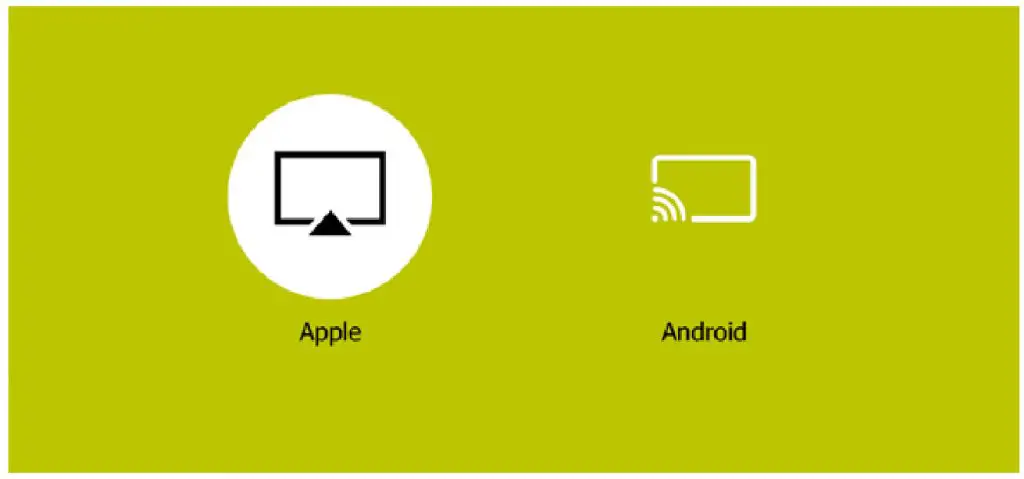
3.5 mm audio output; connect to external speakers or headphones.- Micro USB port
Connect to the power supply. - Focus adjustment knob
Adjust image sharpness.
Side view


♦ Press and hold three seconds to switch the projector on or off.
♦ When the projector is switched on, the LED turns white. When the projector is switched off, the LED turns off.
♦ When charging the projector, the LED turns red in power off mode.- ►
Navigate menu options. - OK
Confirm a selection or entry.

Return to a previous menu screen.
Access home menu
The home menu provides easy access to system setup and other useful features in the projector.
- Turn on the projector. The home menu is displayed.
- Press the ► and OK buttons to select the following.
 • Screen Mirroring: Access screen mirroring function for iPhone and Android device.
• Screen Mirroring: Access screen mirroring function for iPhone and Android device.
• Media Player: Access media players forphoto, music and video.
• Settings & Preferences: Access menus to change settings on the projector.
Initial operation
Placement
Place the projector on a flat surface in front of the projection surface.
Connecting power supply
The projector can be operated by either external power or a built-in battery.
![]() CAUTION!
CAUTION!
Always use the button to turn the projector on and off.
button to turn the projector on and off.
Operation by an external power
• Using the supplied USB cable, connect the USBport on the projector to the supplied power adapter. Then connect the power adapter to the wall outlet.
If needed, select an appropriate power plug adapter (EU, UK, US) for connecting to the wall outlet.
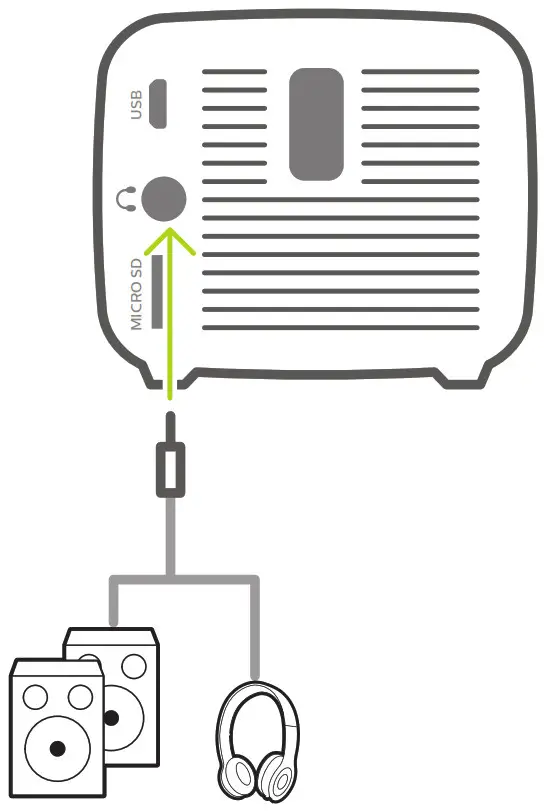
Or, simply using the supplied USB cable, connect the USB port on the projector to a USB port on your computer or a power bank.
Operation by built-in battery
The projector can be also operated on a built-in battery for portability.
Charging projector
Charge the projector for 1.5 hours before first use.
Charge the projector when the low battery icon appears in the center of the projection screen.
• To charge the projector, connect the projector to an external power supply as described in the section of “Operation by external power”.
• When charging, the LED on the projector turns red in power off mode. When fully charged, the red LED turns off.
Notice
![]() The capacity of the built-in battery diminishes with time. If the projector functions only with an external power supply, the built-in battery is defective. Contact an authorized service center to replace the built-in battery.
The capacity of the built-in battery diminishes with time. If the projector functions only with an external power supply, the built-in battery is defective. Contact an authorized service center to replace the built-in battery.
Power on and setup
1 Press and hold on the projector for
3 seconds to switch the projector on or off.
• When the projector is switched on, the LED on the projector turns white.
• When charging, the LED on the projector turns red in power off mode.
Changing screen size
The projection screen size (or size of images) is determined by the distance between the lens of the projector and the projection surface.
• The projection image size is to up to 60’’.
• The projection distance is 40 cm – 180 cm
Image sharpness adjustment
To adjust image focus, turn the focus adjustment knob on the back of the projector.
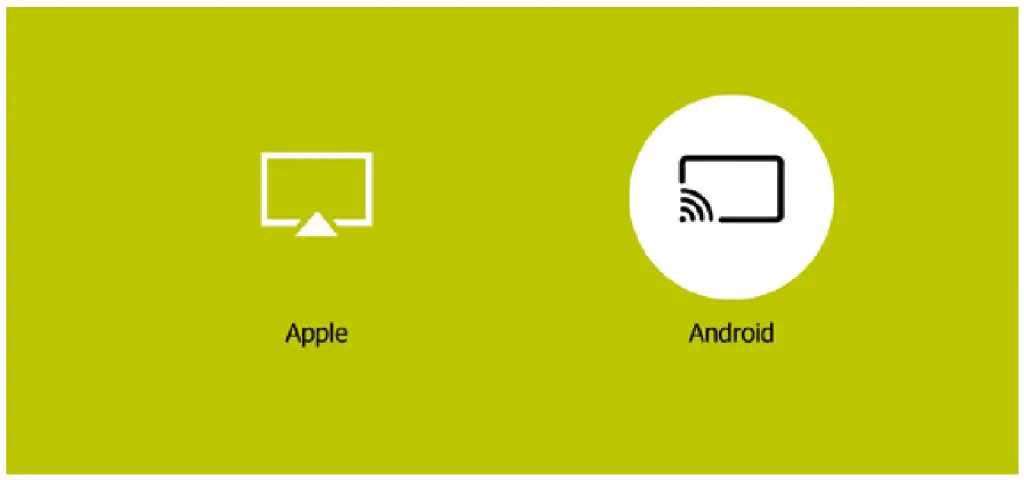
Connect to playback devices
Connecting to external speakers or headphones
Connect external speakers or headphones to the projector. With this connection, audio from the projector is played through the external speakers or headphones.
 DANGER!
DANGER!
The danger of hearing damage!
Before connecting the headphones, turn down the volume on the projector. Do not use the projector over a longer time at high volume – especially when using headphones. This could lead to hearing damage.
- Using a 3.5 mm audio cable, connect the
 connector on the projector to the analog audio input (3.5 mm jack, or red and white jacks) on the external speakers. Or connect the
connector on the projector to the analog audio input (3.5 mm jack, or red and white jacks) on the external speakers. Or connect the  connector on the projector to headphones.
connector on the projector to headphones.
• The speakers of the projector are deactivated automatically when the external speakers or headphones are connected to the projector.
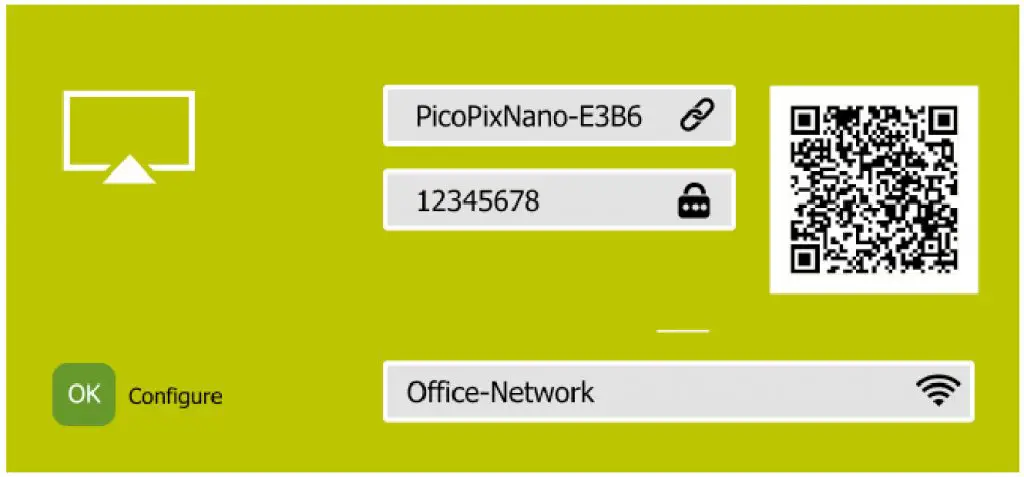
2. Before connecting to the headphones, make sure the volume is adjusted to a comfortable level.
To adjust the volume of the projector, you can use the playback control appearing on the screen during media playback Media playback, page 11.
Wireless projection with Android devices
What you need
• An Android device that supports Miracast (or Screen Mirroring). The feature name can be also known as Screencast, Screen Sharing, WiFi Direct, and Wireless Display, etc. Not all Android devices have this feature. Refer to your device user manual for details.
• Turn on WiFi on your Android device.
1. Turn on the projector. The home menu is displayed.
2. Use the ►button to select Screen Mirroring, and then press OK.

3. The window for selecting a screen mirroring method is displayed: Apple and Android. Select Android to enter the screen mirroring interface.
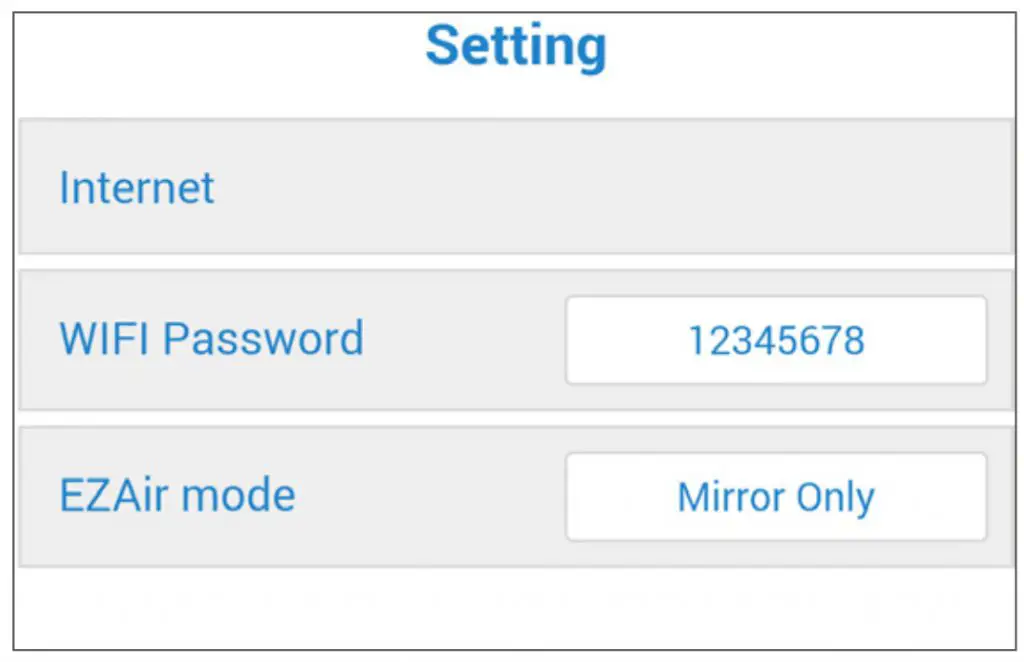 4. In the screen mirroring interface, the projector name is displayed. You are prompted to connect your Android device to the projector.
4. In the screen mirroring interface, the projector name is displayed. You are prompted to connect your Android device to the projector.
5. On your Android device, access the screen mirroring settings, and select the ‘Wireless Display” option. Then select the projector name under ‘Wireless Display’ to connect your Android device to the projector.
6. After successful connection, the screen content of your Android device is cast to the projection surface.
Wireless projection with iOS devices
What you need
• Turn on WiFi on your iPhone.
1. Turn on the projector. The home menu is displayed.
• Or when the projector is in operation, press ![]() to display the home menu.
to display the home menu.
2. Use the ► button to select Screen Mirroring, and then press OK.
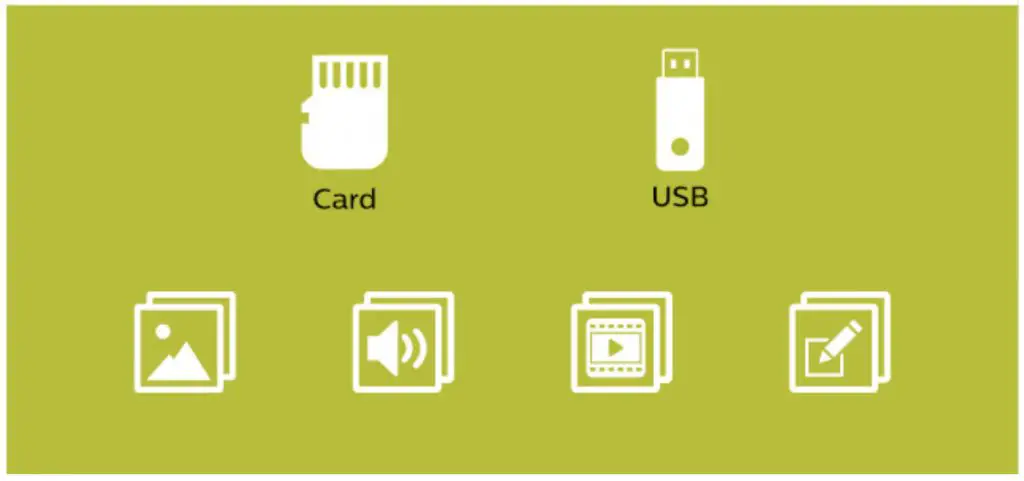
3. The window for selecting a screen mirroring method is displayed: Apple and Android. Select Apple to enter the screen mirroring interface.
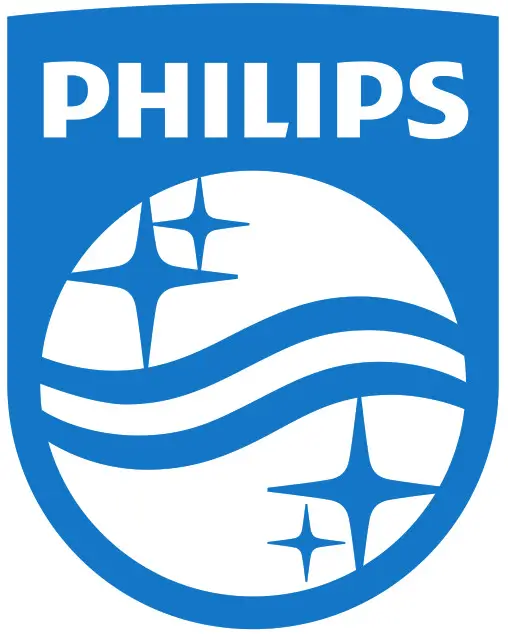
4. In the screen mirroring interface, the projector name and password and an QR code are given.

5. On your iPhone, access the WiFi settings and select the WiFi network of the projector, then connect your iPhone to the projector’s WiFi.
• Or you may scan the QR code using a camera app on your smartphone to connect your iPhone to the projector’s WiFi.
6. On your iPhone, access ‘Control Center’ by sliding the screen up, and select the ‘Screen Mirroring’ option. Then select the projector name under ‘Screen Mirroring’ to connect your iPhone to the projector.
7. After successful connection, the screen content of your iPhone is cast to the projection surface.
Notice
![]() To enable your iPhone to access the Internet when your iPhone is wirelessly projected, connect the projector to the Internet (see Connect to WiFi network, page 10).
To enable your iPhone to access the Internet when your iPhone is wirelessly projected, connect the projector to the Internet (see Connect to WiFi network, page 10).
Trademark notice
Apple, AirPlay, and the AirPlay logo are trademarks or registered trademarks of Apple, Inc. in the US and other countries.
Google, Android, and the Android logo are trademarks or registered trademarks of Google, Inc. in the US and other countries.
Connect to WiFi network
Connect the projector to a WiFi network router, and enjoy:
• Enable your smartphone (iPhone and Android device) to connect to the Internet via the hotspot created by the projector, particularly for iPhone when it is wirelessly projected through the projector.
• Stream online video from your iPhone to be played on the full projection screen.
• Wireless project your iPhone onto the projection screen.
What you need
• A wireless network router.
• For best wireless performance and coverage, use an 802.11n router (“Wi-Fi 4”).
1. On the home menu, use the button to select Screen Mirroring and then press OK.

2. The window for selecting a screen mirroring a method is displayed: Apple and Android. Select Apple to enter the screen mirroring interface.

3. In the screen mirroring interface, select Configure, and press OK to access the WiFi network setting interface.

4. The screen for the instructional steps of the projector connected to the Internet is displayed. See the figure below.

• First connect the projector to your smartphone using either of the following methods. After a successful projector connection to the smartphone, a chain icon is displayed on the top right of the projection screen.
• Use a camera app on your smartphone to scan the QR code on the left side of the screen, as shown in the figure above, or
• access the WiFi settings of your smartphone, then connect the projector to the smartphone using the hotspot and password given in the left side of the screen (as shown in the figure above).
• Secondly access the WiFi network setup using either of the following methods.
• Use a camera app on your smartphone to scan the QR code on the right side of the screen, as shown in the figure above, or
• in the URL field of your smartphone, input the IP address “192.168. xx. xx” (“x” indicates a digit) provided on the right side of the screen as shown in the figure above.
5. The WiFi network setup interface is displayed on your smartphone, and select “Internet” to display the WiFi networks available. Then select your WiFi network and input the password to connect the projector to the WiFi network.
 • The projector is now connected to the Internet (it may take a few minutes to connect the projector to the Internet).
• The projector is now connected to the Internet (it may take a few minutes to connect the projector to the Internet).
• To wirelessly project your iPhone onto the projection screen, select “EZAir mode” then select “Mirror Only” in the WiFi setup interface, as shown in the figure above.
• To cast online video onto the full projection screen, select “EZAir mode” then select “Mirror + Stream” in the WiFi setup interface, as shown in the figure above.
Enable iPhone to access the Internet
When the projector is connected to the WiFi network (Internet), you are provided an alternative to access the Internet on your iPhone.
1. Connect your iPhone to the projector, as described in this chapter.
2. Open the Internet browser on your iPhone to access the Internet.
Media playback
This section helps you use the projector to play media from a wide range of sources.
Notice
![]() The projector supports a USB storage device that is formatted for FAT16 or FAT32 file systems. To access more settings for media playback, see the “Change settings” chapter.
The projector supports a USB storage device that is formatted for FAT16 or FAT32 file systems. To access more settings for media playback, see the “Change settings” chapter.
Movie playback
1. Connect a USB storage device to the USB port of the supplied USB cable. Then connect the supplied USB cable to the USB port on the projector and to the wall outlet
(or to a computer/power bank). See the figure below.
• Recommend using external power when connecting a USB device.
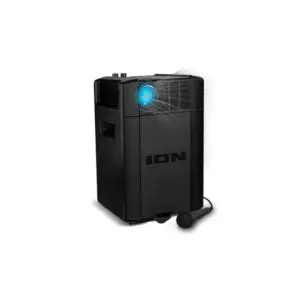
2. On the home menu, select Media Player. The media format options are displayed.
3. Select USB or Card as a media format. The icons for music, video, and photo players are displayed.

• Music icon: access and play audio files only.
• Video icon: access and play video files only.
• Photo icon: access and play photo file only.
4. Select the video icon to activate the video media player and access video files. If a video media player is selected, only the playable video files can be displayed.
5. Select a video file and press OK to play the video.
6. During playback, the playback control bar is displayed on the bottom of the projection screen. Use the and OK buttons to select a playback function, such as volume, pause/resume, repeat play, fast forward/backward, etc.
Music playback
1. Repeat step 1 to 3 in “Movie playback”, and the icons for music, video, and photo players are displayed.

• Music icon: access and play audio files only.
• Video icon: access and play video files only.
• Photo icon: access and play photo file only.
2. Select the music icon to activate the music media player and access music files. If a music media player is selected, only the playable music files can be displayed.
3. Select a music file and press OK to play music.
4. During playback, the playback control bar is displayed on the bottom of the projection screen. Use the ► and OK buttons to select a playback function, such as , volume, pause/resume, repeat play, fast forward/backward, etc.
Photo playback
1. Repeat steps 1 to 3 in “Movie playback”, and the icons for music, video, and photo players are displayed.
 • Music icon: access and play audio files only.
• Music icon: access and play audio files only.
• Video icon: access and play video files only.
• Photo icon: access and play photo file only.
2. Select the photo icon to activate the photo media player and access photo files.
If a photo media player is selected, only the playable photo files can be displayed.
3. Select a photo file and press OK to display the photo.
4. Press the ► button to display the next photos. Or press OK to display the playback control bar on the bottom of the projection screen. Then use the ► and OK buttons to select a playback function, such as rotate pictures, zoom pictures, slide show, file information, and photo display settings.
Change settings
This section helps you change the settings of the projector.
1. On the home menu, select Settings & Preferences to access the settings menu.
2. The icons for a photo, video, music, and system settings are displayed. Use the► and OK buttons to select and change the following settings.
Photo settings
• Aspect Ratio: Select an image display format.
• Slideshow Duration: Select a slideshow interval.
Video settings
• Display Ratio: Select an image display format.
• Repeat Mode: Select a play mode, e.g. play randomly, play the current music file once, repeat the current music file continuously.
Music settings
• Repeat Mode: Select a play mode, e.g. play randomly, play the current music file once, repeat the current music file continuously.
System settings
• Projection Direction: Select a direction of projection corresponding to the particular placement of the projector.
• ECO Mode: Activate or deactivate energy-saving mode. If Auto is selected, energy-saving mode is activated when low battery power occurs.
• Language: Select a language for the onscreen menu.
• Firmware Upgrade: Upgrade system via USB or Micro SD card.
• Firmware version is displayed on the bottom of the system settings interface.
Service
Built-in battery care
The capacity of the built-in battery diminishes with time. You can prolong the life of the battery if you observe the following points:
• Without a power supply, the projector operates on the built-in battery. When the battery does not have sufficient power, the projector turns off. In this case connect the projector to the power supply.
• Charge the battery regularly. Don’t store the projector with a completely discharged battery.
• If the projector is not used for several weeks, discharge the battery a little by using the projector before storing it.
• Keep the projector and the battery away from sources of heat.
Note about the deep discharge of the battery
When the built-in battery is in deep discharge, it may take longer for the actual charging process to start. In this case, charge the projector for at least five hours before using it.
![]() Risk of explosion with the incorrect type of batteries!
Risk of explosion with the incorrect type of batteries!
Do not try to replace the built-in battery yourself.
Cleaning
![]() Instructions for cleaning!
Instructions for cleaning!
Use a soft, lint-free cloth. Never use liquid or easily flammable cleansers (sprays, abrasives, polishes, alcohol, etc.). Do not allow any moisture to reach the interior of the project. Do not spray the projector with any cleaning fluids. Wipe over the surfaces gently. Be careful that you do not scratch the surfaces.
Cleaning the lens
Use a soft brush or lens cleaning paper for cleaning the lens of the projector.
![]() Do not use any liquid cleaning agents!
Do not use any liquid cleaning agents!
Do not use any liquid cleaning agents for cleaning the lens, to avoid damaging the coating film on the lens.
Update software
The latest software of the projector can be found on www.philips.com/support for you to get the best features and support from the projector. Before you update the software of the projector, check the current software version:
• On the home menu, select Settings & Preferences to access the settings menu. Then access the system settings interface. The firmware version is displayed on the bottom of the system settings interface.
![]() CAUTION!
CAUTION!
Do not turn off the projector or remove the USB flash drive or Micro SD card during the update.
Update software through USB or Micro SD card
1 Check the latest software version on www. philips.com/support. Find your product (model number: PPX120), and locate ‘Software and drivers’.
2 Download the software into the USB flash drive. Unzip the downloaded software file and save it in the root directory of the USB flash drive.
• After unzipping, make sure the file is named “DOW_PX.bin”.
3 Connect the USB storage device to the USB port of the supplied USB cable. Then connect the supplied USB cable to the USB port on the projector and to the wall outlet (or to a computer/power bank).
• Recommend using external power when connecting a USB device. 4 Turn on the projector with external power. Go to Settings & Preferences, and navigate to select Firmware Upgrade – USB or SD.
| Problems | Solutions |
| The projector cannot be turned on. | •Disconnect and reconnect the power cable, and try to turn the projector on again.
•Low battery power. Connect the projector to an external power supply. |
| The projector cannot be turned off | •Press and hold 0 longer than ten seconds. If this does not work, disconnect the power cable. |
| The projector turns itself off. | •Low battery power.
•When the projector is running for a long period of time, the surface becomes hot. •Check that the power cable is connected correctly. |
| The projector cannot read the USB stick. | •When connecting a USB device to the projector using the supplied USB cable, use an external power supply to power the projector, not built-in battery.
•The projector does not support the exFAT file system. •Format the USB stick in FAT format, then use it. |
| Measures to take if Screen Mirroring does not work anymore after a firmware update of an Android or iOS device? | •We recommend checking regularly for new firmware of your projector (see Update software. page 14). |
| Screen mirroring does not work with the available Android device. | •In order to allow screen mirroring, your device must support Miracast. Not all Android devices support this function. The function name can be also known as Screencast. Screen Sharing. WiFi Direct. Wireless Display. etc..
• Please refer to the user manual of your Android device to check if this function is supported and how it can be enabled. |
| When I view videos, the sound or the picture is sometimes distorted or the sound is not synchronized to the picture. | •The available WiFi bandwidth is insufficient for sending the video flawlessly from the smartphone to the projector. This can happen if one or more WiFi networks operate in the same frequency range nearby. Certain loT devices (e.g. ZigBee enabled devices) also operate in this frequency range.• Your smartphone is not fast enough to compress the screen data and send it simultaneously over WiFi.• Your smartphone may maintain parallel connections to your home network and the projector. This will reduce the available bandwidth. Disabling temporarily the connection to your home network may help. |
| The temperature of the projector’s surface is warm. | • For this projector it is normal to generate moderate heat during operation. |
Appendix
Technical data
Technology/optical
Display technology …………………………Ti DMD DLP
Light source ……………………………………. OSRAM LED
Resolution ……………………………….. 640 x 360 pixel
Resolution supported ………….. 1920 x 1080 pixel
LED lifetime …………………..last over 20.000 hours
Contrast ratio ………………………………………………. 500:1
Aspect ratio ……………………………………..16:9 and 4:3
Throw ratio ……………………………………………………1.68:1
Brightness ……………………up to 100 Color Lumens
Recommended screen size (diagonal) …… 8” to 60”
Recommended screen distance …………….40 cm – 180 cm
Focus adjustment …………………………………….manual
Integrated media player ………………………………… yes Sound
Internal Speaker ………………………………….. 2 W (max)
Connection
Wi-Fi ……………… Miracast and iOS Airplay screen mirroring;
Micro USB …………………………………………………………… x1
Micro SD card ……………………………………………………. x1
Output audio …………………. 3.5 mm audio out jack for headphones, USB 2.0 (via Micro USB adapter)
Power source
Power charger adapter ……………………………… 5V, 2A
Built-in battery ……………………………………. 1800mAh
…………………………………….. last up to 80 minutes
Product details
Dimensions (W × D × H) ……… 62 x 52.3 x 48 mm
……………………………….. 2.44 x 2.06 x 1.89 inches
Weight ……………………………………………. 136 g / 0.3 lb
Operating temperature……………………………. < 40 °C
Storage temperature ……………………………….. < 60 °C
Package content
PicoPix Nano projector, USB cable, AC adapter,
power plugs (EU, UK, US), travel pouch, Quick
Start Guide

The CE marking certifies, that the product meets the main requirements of the European Parliament and Council directives Directive 2014/53/EU (RED), Directive 2009/125/EC (ERP), EC Regulation 1907/2006 (REACH), Directive 2011/65/EU (RoHS), Directive 2012/19/EU (WEEE) on information technology equipment, regarding safety and health of users and regarding electromagnetic interference. The Declaration of Compliance can be consulted on the site www.philips.com/projection.
Preservation of the environment as part of a sustainable development plan is an essential concern of Screeneo Innovation SA. The desire of Screeneo Innovation SA is to operate systems respecting the environment and consequently it has decided t o integrate environmental performances in the life cycle of these products, from manufacturing to commissioning use and elimination.

Federal Communications Commission (FCC) Statement: You are cautioned that changes or modifications not expressly approved by the party responsible for compliance could void the user’s authority to operate the device. This device has been tested and found to comply with the limits for a Class B digital device, pursuant to part 15 of the FCC rules. These limits are designed to provide reasonable protection against harmful interference in a residential installation. This device generates, uses and can radiate radio frequency energy and, if not installed and used in accordance with the instructions, may cause harmful interference to radio communications. However, there is no guarantee that interference will not occur in a particular installation. If this device does cause harmful interference to radio or television reception, which can be determined by turning the device off and on, the user is encouraged to try to correct the interference by one or more of the following measures:
• Adjust or relocate the receiving antenna.
• Increase the separation between the device and receiver.
• Connect the device into an outlet on a circuit different from that to which the receiver is connected.
• Consult the dealer or an experienced radio/TV technician for help.
This device complies with Part 15 of the FCC
Rules. Operation is subject to the following two conditions:
1. this device may not cause harmful interference;
2. this device must accept any interference received, including interference that may cause undesired operation.
FCC RF Radiation Exposure Statement:
This transmitter must not be in co-location or operating in conjunction with any other antenna or transmitter. This device complies with FCC RF radiation exposure limits set forth for an uncontrolled environment. This device should be installed and operated with a minimum distance of 20 centimeters between the device and your body.
FCC ID: 2ASRT-PPX120
Canada Regulatory Compliance
This device complies with Industry Canada CAN ICES-3 (B)/NMB-3(B)
RSS-Gen & RSS-247 statement: This device complies with Industry Canada RSS standard(s).
Operation is subject to the following two conditions:
1. This device may not cause interference, and
2. This device must accept any interference, including interference that may cause undesired operation of the device.
RF Radiation Exposure Statement: The device meets the exemption from the routine evaluation limits in section 2.5 of RSS102 and users can obtain Canadian information on RF exposure and compliance.
This device should be installed and operated with a minimum distance of 7.8 inches (20 centimetres) between the device and your body.

Packaging: The presence of the logo (green dot) means that a contribution is paid to an approved national organization to improve package recovery and recycling infrastructures. Please respect the sorting rules set up locally for this kind of waste. Batteries: If your product contains batteries, they must be disposed of at an appropriate
collection point.

Product: The crossed-out waste bin symbol on the product means that the product belongs to the family of electrical and electronic equipment. In this respect, the European regulations ask you to dispose of it selectively:
• At sales points in the event of the purchase of similar equipment.
• At the collection points made available to you locally (drop-off centre, selective collection, etc.).
In this way you can participate in the reuse and upgrading of Electrical and Electronic Equipment Waste, which can have an effect on the environment and human health. The paper and cardboard packaging used can be disposed of as recyclable paper. Have the plastic wrapping recycled or dispose of it in the non-recyclable waste, depending on the requirements in your country.
Trademarks: The mentioned references in this manual are trademarks of the respective companies. The lack of the trademarks ® and ™ does not justify the assumption that these dedicated terminologies are free trademarks. Othe product names used herein are for identification purposes only and may be trademarks of their respective owners. Screeneo Innovation SA disclaims any and all rights in those marks. Neither Screeneo Innovation SA nor its affiliates shall be liable to the purchaser of this product or third parties for damages, losses, costs, or expenses incurred by the purchaser or third parties as a result of an accident, misuse, or abuse of this product or unauthorized modifications, repairs, or alterations to this product, or failure to strictly comply with Screeneo Innovation SA operating and maintenance instructions.
Screeneo Innovation SA shall not be liable for any damages or problems arising from the use of any options or any consumable materials other than those designated as original Screeneo Innovation SA/PHILIPS products or Screeneo Innovation SA/PHILIPS approved products. Screeneo Innovation SA shall not be held liable for any damage resulting from electromagnetic interference that occurs from the use of any interface cables other than those designated as Screeneo Innovation SA/PHILIPS products.
All rights reserved. No part of this publication may be reproduced, stored in a retrieval system, or transmitted in any form or by any means, electronic, mechanical, photocopying, recording, or otherwise, without the prior written permission of Screeneo Innovation SA. The information contained herein is designed only for use with this product. Screeneo Innovation SA. is not responsible for any use of this information as applied to other devices.
This user manual is a document that does not represent a contract.
Errors, printing errors and changes are reserved.
Copyright © 2019 Screeneo Innovation SA.

PHILIPS and the PHILIPS’ Shield Emblem have registered trademarks of Koninklijke Philips N.V. used under license.
This product was brought to the market by Screeneo Innovation SA., further referred to in this document as Screeneo Innovation SA., and is the manufacturer of the product.
2019 © Screeneo Innovation SA.
All rights reserved.
Headquarters:
Screeneo Innovation SA.
Route de Lully 5C
1131 – Tolochenaz – Switzerland
www.philips.com/welcome